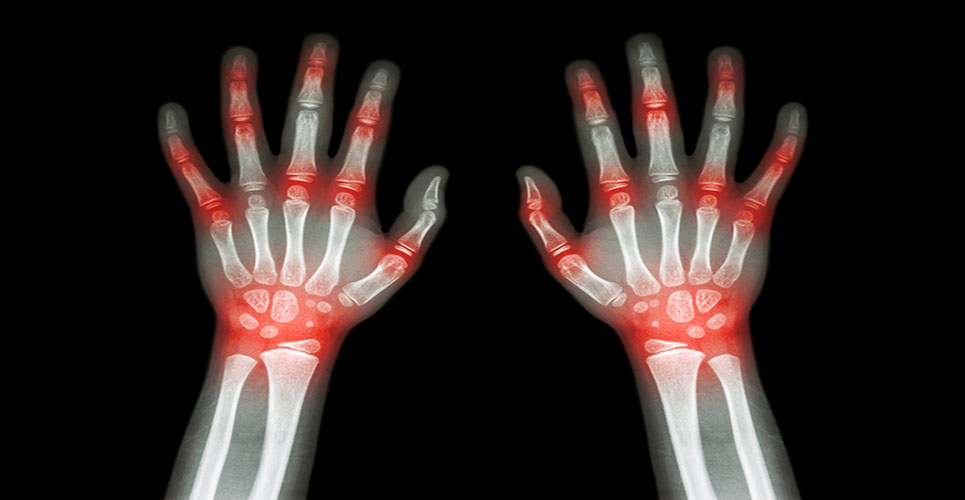Data has been released that support the recent label enhancement for Stelara in reducing the rate of progression of structural damage, which represents an important milestone for people living with psoriatic arthritis.
Approximately 14 million people in Europe are affected by psoriasis. Over time, up to 30% of these people may develop psoriatic arthritis.
Data has been released that support the recent label enhancement for Stelara in reducing the rate of progression of structural damage, which represents an important milestone for people living with psoriatic arthritis.
Approximately 14 million people in Europe are affected by psoriasis. Over time, up to 30% of these people may develop psoriatic arthritis.
Stelara is now approved for use in line with anti-tumour necrosis factor (TNF)-alpha therapies for the treatment of psoriatic arthritis in Europe. This means that physicians and patients now have an additional treatment choice with a different mode of action to help them manage psoriatic arthritis.
This label enhancement follows the publication of data from two pivotal phase III studies, PSUMMIT I and II. The data supported the effect of Stelara in reducing the rate of progression of structural damage in the treatment of active psoriatic arthritis and demonstrated significant and sustained improvements in reducing the signs and symptoms of psoriatic arthritis, physical function and health-related quality of life over 2 years.
Key highlights
- Treatment with ustekinumab significantly slowed progression of structural joint damage over 24 weeks versus placebo, with inhibition maintained through 52 and 100 weeks of continued treatment (Kavanaugh A, et al.; McInnes IB, et al.)
- After 100 weeks, a majority of patients receiving ustekinumab had a clinical improvement in their psoriasis severity (Kavanaugh A, et al.)
- After 52 weeks, up to three-quarters of patients receiving ustekinumab had achieved Psoriatic Arthritis Response Criteria (PsARC) response (McInnes IB, et al.)
- Ustekinumab was well tolerated and rates of serious infections, malignancies and major adverse cardiovascular events (MACE) were generally low in all patients treated with ustekinumab for 2 years (Kavanaugh A, et al.)
Oral presentation
Ustekinumab is effective in inhibiting radiographic progression in patients with active psoriatic arthritis: Integrated data analysis of two Phase 3, randomised, placebo-controlled studies – McInnes IB, et al.
- The study evaluated the effect of ustekinumab (45 mg and 90 mg) on the progression of structural damage to the joints in patients with active psoriatic arthritis (PsA) participating in the PSUMMIT 1 and 2 trials, after 24 and 52 weeks of treatment.
- Continued inhibition of radiographic progression was seen up to week 52 in patients continuously treated with ustekinumab.
- After 24 weeks, patients treated with ustekinumab showed significantly lower radiographic progression compared with those treated with placebo, as assessed by total vdH-S, a PsA-modified score assessing joint erosion seen on X-rays and narrowing of the joint space (p<0.017).
- Patients crossed over from placebo to ustekinumab at weeks 16 or 24 showed slowing of structural damage by week 52.
Poster
Efficacy and safety of ustekinumab in patients with active psoriatic arthritis: 2-year results from a Phase 3, multicentre, double-blind, placebo-controlled study –Kavanaugh A, et al.
- The study evaluated the long-term clinical and radiographic efficacy of ustekinumab (45 mg and 90 mg) in patients with PsA participating in the PSUMMIT-1 trial, over 108 weeks of treatment. The total duration of the trial was 108 weeks, but the vdH-S and PASI scores were assessed at 100 weeks.
- At week 24, a significantly higher proportion of patients treated with ustekinumab versus placebo had American College of Rheumatology 20, 50 and 70 responses and greater improvements in Health Assessment Questionnaire Disability Index (HAQ-DI) score.
- Clinical improvements were generally maintained through 100 weeks of treatments; at week 100, a majority of patients had a 75% improvement in Psoriasis Area Severity Index (PASI) score (patients crossed from placebo to ustekinumab, 63.9%; ustekinumab 45 mg, 72.5%; ustekinumab 90 mg, 71.3%).
- Ustekinumab significantly inhibited radiographic progression at week 24 versus placebo, as assessed by total vdH-S, with effects maintained through to week 100.
- Rates of serious infections, malignancies and MACE were generally low in all patients treated with ustekinumab.
- Ustekinumab was generally well tolerated with a safety profile consistent to that seen in psoriasis.
Abstract
Early and sustained modified PsARC response in psoriatic arthritis patients treated with ustekinumab: Results from PSUMMIT 1 and PSUMMIT 2– McInnes IB, et al.
- The study evaluated the modified PsARC in patients with PsA participating in the PSUMMIT 1 and 2 trials. PsARC score is a modified version of the ACR score and is used to assess the number of tender and swollen joints often affected in patients with PsA.
- After 52 weeks, up to three quarters of patients receiving ustekinumab had achieved PsARC response(PsARC response rates in PSUMMIT 1 and 2, at week 52 respectively: patients crossed from placebo to ustekinumab, 75.5% and 64.9%; ustekinumab 45 mg, 73.2% and 58.5%; ustekinumab 90 mg, 74.6% and 60.0%).
- As early as week 4, significantly more patients treated with ustekinumab in the PSUMMIT 1 trial had achieved a PsARC response compared with those treated with placebo (PsARC response rates: placebo, 27.5%; ustekinumab 40 mg, 37.1%; ustekinumab 90 mg, 38.5% [p<0.05 for both doses versus placebo]).
- Across both trials, a significantly higher PsARC response rate was observed at weeks, 8, 12 and 24 for ustekinumab compared with placebo.
- Patients crossed over from placebo to ustekinumab at weeks 24 and 28 achieved similar response rates thereafter as those who received ustekinumab throughout the entire trial .

